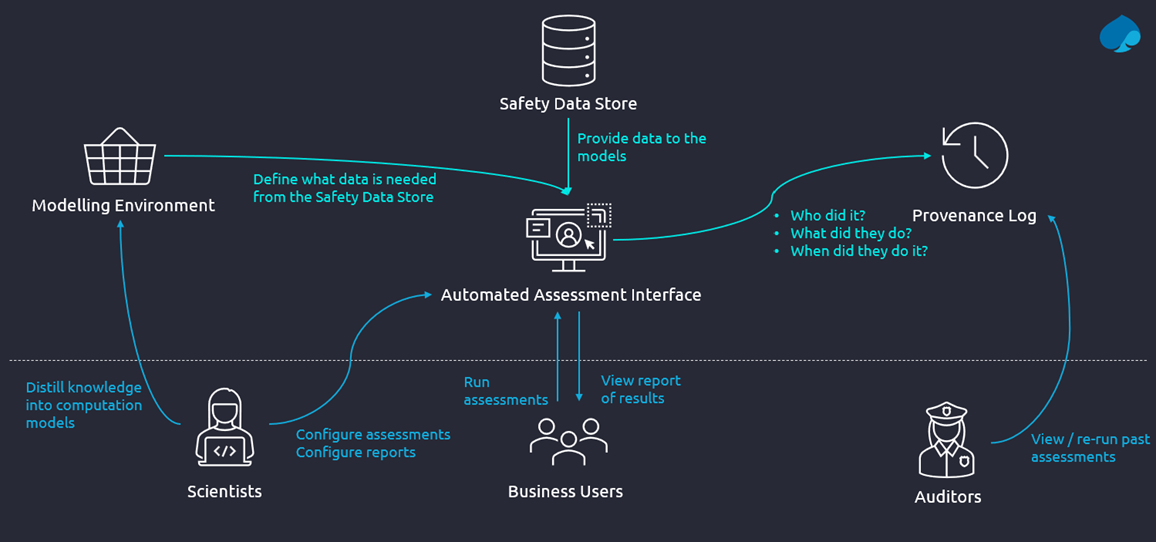To ensure a consumer product is ready to release to market, thorough safety and regulatory assessments must be completed. Each substance included in a product formulation, the formulation as a whole, and necessary packaging and processing are assessed, in order to identify and mitigate risks to consumer safety.
This process may cover many safety and regulatory domains. Such domains include:
- The human toxicological risk profile of each substance
- The claims that can be made about animal testing, ecotoxicology, and biodegradability
- Packaging physical hazards and labelling
- Microbiology
- Occupational safety
An assessment of safety assessments
The expert safety assessor’s skills are required to assess novel substances and uses, but a full safety and regulatory assessment can take a trained professional hours (or days) to complete. If supplier data is required to support an assessment, this can add weeks to the process.
However, not every product going to market has a brand-new formulation or uses substances that have never been assessed before. For example, your favorite shampoo may simply have a new fragrance, and a new kitchen cleaning spray may be made of substances that have been assessed as safe at similar levels for similar products. Despite these very minor changes, a full assessment is often still conducted by expert safety assessors before the new product can be released to market.
Yet it is possible – through automation – for the formulator to run a full safety assessment with no expert involvement.
Introducing automation
A repetitive, defined process (which does not require expert human decision making) is where automation thrives. By automating the assessment of these minor changes, the assessor’s time can be saved for when their expert knowledge is really required.
Capgemini Hybrid Intelligence recently partnered with a leading FMCG client to specify, design and develop their new automated safety assessment system. In the first year, thousands of assessments were conducted, with the majority requiring no expert assessor involvement. This has given unprecedented assessment coverage and consistency, as well as saving considerable time for expert risk assessors. These experts now have time to devote to exploratory science and assessing innovative materials and product formulations.
The building blocks of this system are outlined below.

The building blocks of automated assessment
The first and most important building block to automate assessment is a Safety Data Store. Any data that the expert risk assessor would use to form the basis of their risk assessment will need to be in a well-managed data store.
This might include the toxicological risk profiles for each substance, safe levels of inclusion for different product types, or even the wording of labelling advice. The data should adhere to the FAIR principles: findability, accessibility, interoperability, reusability – and should be tightly governed to ensure its quality.
The next building block is a Modelling Environment to hold the rules and logic of the assessments. The expert assessor’s knowledge and processes must be distilled into computational models that will produce the same risk outcome as the expert would have. The models are linked together to produce complex processes and are fed data from the Safety Data Store.
These models should be well governed, to ensure the correct logic is being executed during each assessment. They should have a clear lifecycle, from creation, through testing and approval for use, and eventual retirement when a new version is needed.
To ensure the auditability of the automated system, the next building block is a Provenance Log. This log contains the information on ‘who did what’, and when. It allows an auditor to identify which data was used, which model logic was executed, and ultimately how the final assessment outcome was achieved.
The final building block is an Automated Assessment Interface. This provides the buttons a user can click to execute assessments on a given product and view their outcomes. Should the automated assessment fail, the expert assessor can apply their knowledge to investigate further.
Additionally, the Automated Assessment Interface allows expert assessors to create assessment types for different scenarios, such as releasing a new product to market or making a biodegradability or no animal testing claim. The expert selects the subset of models which are needed to assess the product for a given scenario. Formulators, who are not trained to conduct assessments, can simply select their scenario and the automated system will conduct the assessment.
Conclusion
Capgemini consultants used their industry and technology expertise to specify, design and deliver an automated assessment platform in partnership with an FMCG client.
Now in operation, this platform delivers trusted, repeatable results based on high quality easy-to-maintain data. Automated assessments can now be run multiple times without mounting costs from expert assessor’s time. Formulators can therefore run assessments earlier in the product lifecycle, allowing them to design for safety, reducing the time taken and number of iterations needed to develop a product that will pass the safety assessments.
This reduces the time to market for product innovations and renovations, creating large cost savings.







































